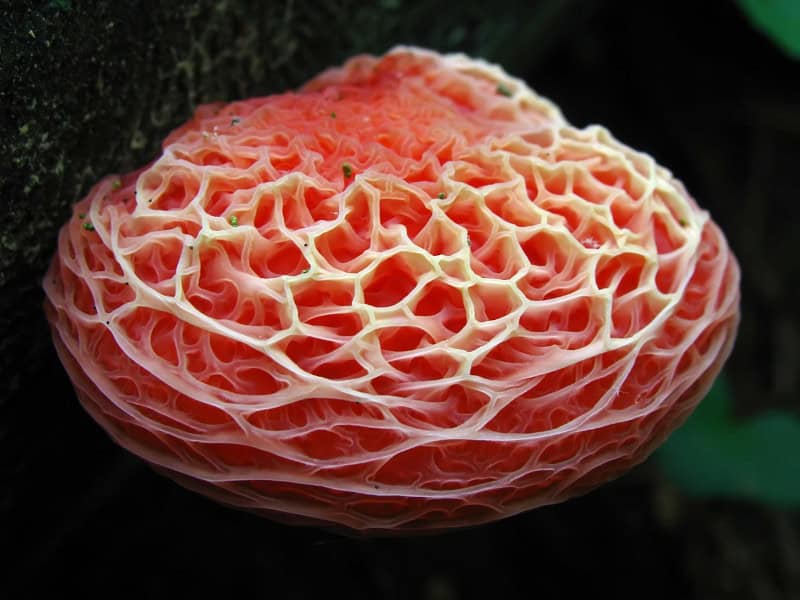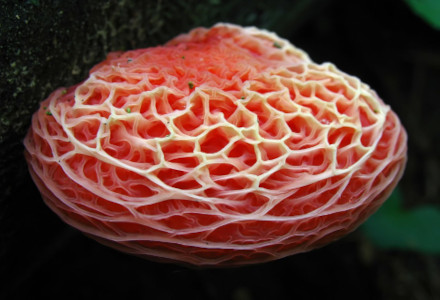
Rosy Veincap Facts
- This remarkable variety of fungus most frequently goes by the unique yet descriptive common name of the Rosy Veincap. It does have other, less often used titles, though. Those include such interesting terms as wrinkled peach and netted rhodotus.
- Within scientific circles, however, it’s referred to by its technical name. Thankfully for the layperson, that’s a comparatively simple term, as such go. That’s because this product of evolution and Nature bears the official moniker of Rhodotus palmatus.
- The distinctive mushroom received its original name due to the efforts of Jean Baptiste Francois Pierre Bulliard. The noted French botanist recorded the first acknowledgement of it as a separate and distinct species. He managed this is 1785.
- However, later researchers reclassified it a number of different times. Experts eventually reclassified it as the sole member of the genus Rhodotus. The French mycologist, René Maire, most recently placed this marvelous species there in 1926.
- Sadly, though, the gorgeous Rosy Veincap appears to be declining rapidly in numbers. That unfortunate trend further seems to hold true throughout the entirety of its known range. The IUCN therefore currently lists it as Near Threatened on its Red List.
- It presently faces several threats to its continued existence as a species. For the moment, the leading cause of its decline appears to be habitat degradation and outright loss. Understandably, it also now finds itself at risk due to the perils of climate change.
Related Articles
Rosy Veincap Physical Description
The impressive fungi known as the Rosy Veincap captures the attention of most people who encounter it. It does not do so due to sheer physical size, though. That’s true since this marvel of Nature ranks as average-sized for a mushroom. But Nature made up for that.
Nevertheless, its dimensions do bear noting, at least. The stem typically develops between 0.6 – 1.2 in (1.5 – 3 cm) in height. That same part of the structure generally attains a width of 0.16 – 0.24 in (0.4 – 0.6 cm) in thickness. It’s also usually thicker closer to the base.
The cap of the beautiful product of Nature also achieves respectable dimensions. This portion begins formation with a somewhat convex shape. As the individual ages, though, this generally flattens out. It attains an average diameter ranging from 0.8 – 2.4 in (2 – 6 cm).
This same structure of the Rosy Veincap displays yet another appealing characteristic, too. These most commonly roll inward, creating an intriguing pattern. The surface of that cap further tends to develop a network of lightly colored structures called ridges or veins.
It also possesses a texture best described as gelatinous. Its internal flesh develops as relatively firm, though rubbery, as well as light pink in color. The exterior color varies depending on lighting conditions, but usually ranges from red to pink to a salmon-orange.
- Kingdom: Fungi
- Phylum: Basidiomycota
- Class: Agaricomycetes
- Order: Agaricales
- Family: Physalacriaceae
- Genus: Rhodotus
- Species: R. palmatus
Rosy Veincap Distribution, Habitat, and Ecology
Fortunately for it, the Rosy Veincap evolved as native to an extremely wide range of the surface of the earth. In fact, the nature and extent of that range may surprise many people. Examples appear in Europe, Asia, part of Africa, and North America. That’s a wide range!
In Africa, the species only appears in the northern sections of the continent. In North America, it’s been spotted in the eastern sections of both Canada and the United States. It’s presently unknown if it ever appeared anywhere outside this extensive zone of habitation.
The species has shown itself to possess a moderate degree of flexibility in its choice of habitat types. As a general principle, though, it seems to prefer regions that are flooded on a periodic basis. It further prefers these regions to receive only limited amounts of sunlight.
Like many related species, this most frequently consists of areas shaded by forest canopies. The fungi most often grows in small clusters on rotting hardwood trees. While it lives on many trees, it does seem to display a preference for maple, basswood, and especially elm.
Like all fungi, the Rosy Veincap reproduces via spores. In its case, these microscopic structures have a roughly spherical shape. Again following a pattern common to its kind, this natural wonder releases those spores at various times of the day, depending on conditions.
Though not toxic to humans, it’s generally considered inedible. It does, however, show moderate promise in medical research. A research study indicated that it displayed mild to moderate antibacterial effects against several tested bacteria strains in the laboratory.
Species Sharing Its Range
Check out our other articles on 5 Woefully Rare Woody Shrubs, European Honey Buzzard, Sacred Valley, Ribbon Seal, Franklin’s Bumblebee, Bluespotted Ribbontail Ray, Orinoco River

